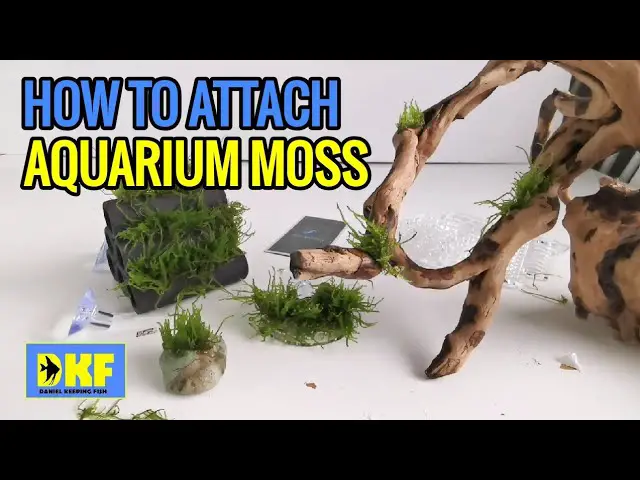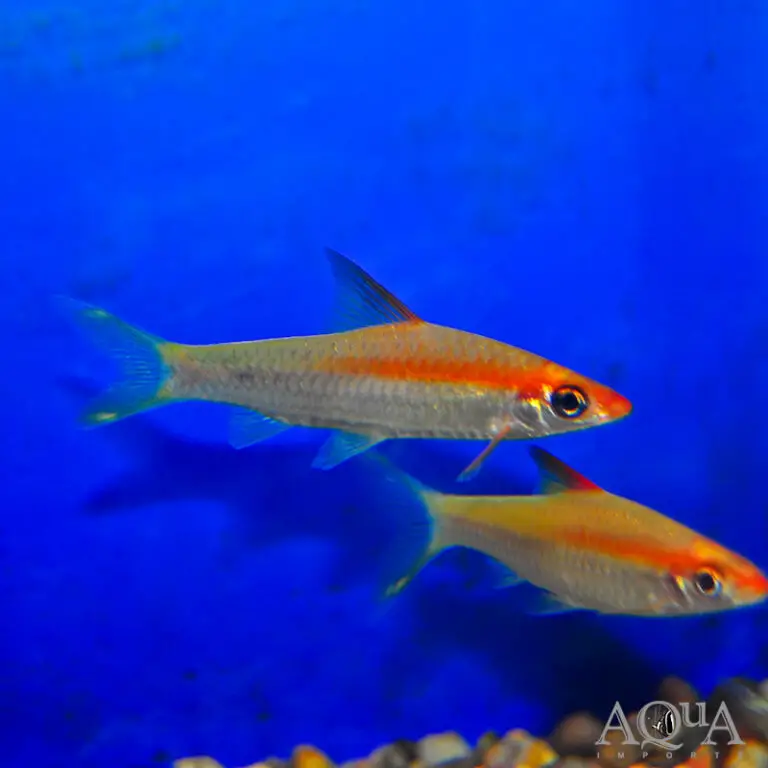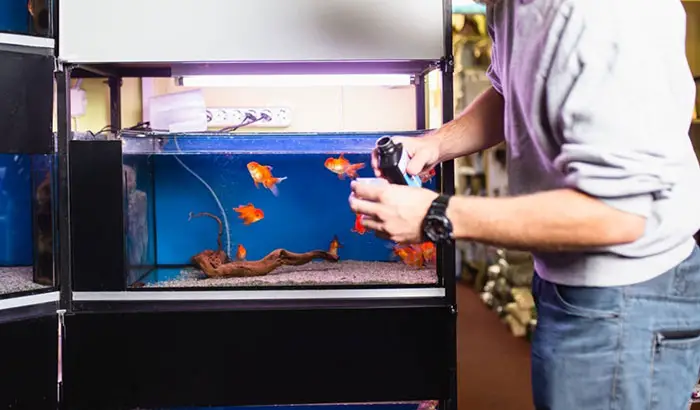How to Sanitize Aquarium Plants?
1. Choose hardy aquarium plants that can withstand water sanitization for the best results.
2. Remove any dead leaves, algae and debris from the plants with a soft bristled brush or toothbrush before introducing them to your tank.
3. Submerge the plants in warm water with a solution of 1 teaspoon of bleach per gallon, making sure they are completely submerged and swish them around gently for 2-5 minutes.
4. Rinse off the bleach solution with clean cool tap water until no bleach is detectable on the plants or in the rinse bath water (test this by dipping a test strip).
5. Place all treated aquarium plants into a fresh container filled with dechlorinated or conditioned aquarium water. Making sure each plant is fully immersed in order to rehydrate it after being submerged in chlorine-bleach solution earlier on. Leave them there for 30 minutes to overnight depending on their size and toughness before adding them back into your tank’s environment.
- Gently remove all aquarium plants from the tank and place them in a container of warm water
- Add one tablespoon of bleach to each gallon of water in the container and stir until it is evenly mixed throughout
- Soak the plants for 15 minutes to ensure they are thoroughly sanitized, then rinse with clean water several times before returning them to the aquarium tank
- Make sure you dry off any excess moisture on each plant before placing back into your aquarium environment so as not to introduce additional bacteria or contaminants that can disrupt your tank’s biological balance.
How to Disinfect Aquarium Plants With Bleach?
Bleach can be used to disinfect aquarium plants, but it should only be done in extreme circumstances when all other options have been exhausted. To do so, first rinse the plant off with clean water and then submerge it for 15 minutes in a solution of 1/4 cup bleach per gallon of water. Afterwards, rinse the plant thoroughly with clean water multiple times until you no longer smell any traces of bleach.
Finally, dip the plant back into freshwater before adding it to your tank.
How Long Should I Quarantine New Aquarium Plants?
When adding new plants to your aquarium, it is important to quarantine them for at least two weeks before placing them in the tank. This will allow you time to make sure that any pests or diseases carried by the plants do not spread to other inhabitants of the tank. Quarantine also gives you a chance to observe how well the plant adjusts and acclimates itself without having an adverse impact on existing tank conditions.
How to Treat Aquarium Plants for Snails?
To treat aquarium plants for snails, it is important to first identify the type of snail infestation. If the snails are a small species such as bladdersnails, pondsnails or ramshorns, they can be manually removed from the tank and either disposed of or put into another tank where they will not cause damage. For larger species such as Malaysian trumpet snails, a chemical treatment may be necessary to effectively eradicate them.
Copper-based treatments are most commonly used but it is important to research any chemicals before using them in an aquarium environment.
Additionally, keeping the aquarium clean and maintaining proper water parameters can help prevent future infestations of aquatic pests like snails.
How to Quarantine Aquarium Plants?
Quarantining aquarium plants is an important step for any new plant you bring into your tank. It helps to prevent the introduction of pests, diseases, and other unwanted contaminants that can cause harm to the health of your fish and other aquatic life. To quarantine a plant, place it in its own container with fresh water and aquarium salt for 7-10 days before adding it to your aquarium.
During this time, inspect the plant closely for signs of disease or parasites before introducing it into the tank.
How to Clean Live Plants before Putting in Aquarium?
When introducing live plants into your aquarium, it is important to clean them first in order to prevent the spread of disease. To do this, remove any dead or dying leaves and rinse off the plant with warm water. Then, dip the plant in a solution of 1 part hydrogen peroxide to 5 parts water for 30 seconds before rinsing thoroughly and planting in your aquarium.
This process will help ensure that no unwanted bacteria or parasites make their way into your tank.
How to Clean Live Aquarium Plants With Vinegar?
Live aquarium plants provide oxygen and natural filtration for your tank, but they can also be breeding grounds for bacteria and algae. To keep these pesky organisms at bay without harming your fish or other aquatic life, you can use vinegar to clean live aquarium plants. Simply fill a bowl with 1 part white vinegar to 3 parts water and soak the plants in it for 30 minutes before rinsing them off with fresh water.
This will help remove any unwanted residue from the leaves while still keeping your tank healthy!
Disinfect Aquarium Plants Hydrogen Peroxide
Disinfecting aquarium plants with hydrogen peroxide is an effective way to remove unwanted bacteria and pathogens. Mix a solution of one part hydrogen peroxide to five parts water, and soak the plants for about 15 minutes. After soaking, rinse them off with clean water before returning them to your tank.
This method should be used sparingly as it can damage some plant species if not used correctly.
Quarantine Aquarium Plants in a Bucket
Quarantining aquarium plants in a bucket is a simple and effective way to ensure that no unwanted pests or diseases are introduced into your tank. This can be done by filling a large bucket with dechlorinated water, adding the new plant, and then keeping it separate from the rest of the tank for at least 14 days before introducing it into the aquarium. During this time, you should check daily for any signs of infestation or disease before allowing it to join its new home.
Quarantine aquarium plants in buckets will help keep your fish safe and healthy!
:strip_icc()/cleaning-aquarium-plants-1381082-hero-023647932fb74728b52b036d8d3b52e5.jpg)
Credit: www.thesprucepets.com
Can I Disinfect Aquarium Plants With Vinegar?
Yes, you can clean and disinfect aquarium plants with vinegar. Vinegar is a natural cleaning product that has been used for centuries to remove bacteria and dirt from items around the home. It’s also safe to use in your aquarium tank!
To properly clean your aquarium plants with vinegar, fill a container or bucket large enough to hold the plants and fill it halfway with lukewarm water. Add 1/4 cup of white vinegar for every gallon of water and stir until fully combined. Place all of the aquarium plants into this mixture and let them soak for 10 minutes before removing them from the solution.
After soaking, rinse off each plant thoroughly under running tap water to remove any excess vinegar residue that may remain on the leaves or stems. Finally, place back into your tank for an added boost of freshness!
How Do You Disinfect Plastic Aquarium Plants?
When it comes to keeping your aquarium clean and healthy, disinfecting plastic aquarium plants is one of the most important things you can do. Not only does this prevent the spread of bacteria and other contaminants, but it also helps keep algae growth down in your tank. Fortunately, disinfecting plastic aquarium plants is a relatively simple process that can be done with household items.
The first step is to rinse off any debris or dirt from the plant using cool tap water. Once rinsed off well, mix up a solution containing 1 teaspoon of bleach per gallon of water in a bucket or container that is large enough to submerge your plant into. Submerge the plant into this solution for 15-20 minutes before removing it and rinsing off with cool tap water again until all traces of the bleach are gone from its surface.
Finally, place back into its original position within your tank and enjoy watching your fish swim around their newly cleaned environment!
How Do You Disinfect Plants?
Disinfecting plants is an important step in any home gardening process as it helps to protect the health of your family, pets and yourself. To effectively disinfect plants, you should first ensure that all leaves are free from dirt and debris by cleaning them with a damp cloth or soft brush. Once done, you can use either a chemical spray or natural solution to disinfect the plant:
For chemical sprays, look for products specifically designed for disinfecting plants such as those containing copper sulfate pentahydrate. Spray liberally on both sides of each leaf and make sure to reach deep into the crevices of stems where bacteria can hide out. Allow at least 10 minutes before rinsing off with clean water.
Alternatively, if you prefer more natural methods then try using vinegar-water solutions (a ratio of 3 parts water to 1 part white vinegar). As with the chemical sprays above, be sure to cover both sides of each leaf thoroughly and allow at least 10 minutes before rinsing off with clean water again afterwards.Whichever method you choose – chemical spray or natural solution – be sure not only to follow instructions carefully but also wear protective gear such as gloves when handling potentially harmful chemicals so that your skin is kept safe from harm too!
Is Hydrogen Peroxide Safe for Aquarium Plants?
When it comes to aquarium plants, many hobbyists are interested in finding out if hydrogen peroxide is safe for them. The answer is yes, but with one caveat: you must use it correctly and sparingly. Hydrogen peroxide (H2O2) can be used as a disinfectant treatment for aquarium plants to eliminate parasites or bacteria that may have taken up residence on their leaves or stems.
However, it should not be used as a regular maintenance solution because the concentration required to kill these organisms would also harm your aquatic plants’ cells and cause tissue damage over time – leading to diminished growth rates and even death of the plant. To ensure safety when using hydrogen peroxide on aquarium plants, always dilute the H2O2 at least 5 parts water : 1 part H2O2; any higher concentrations could potentially do more harm than good! Additionally, don’t forget to remove fish from your tank while applying this treatment since they too could suffer ill effects from exposure.
Finally, avoid spraying directly on open wounds or cuts in the leaves/stems of your aquatic flora; instead use cotton swabs soaked in diluted H202 and lightly dab only affected areas until healed. With proper cautionary measures taken into account when applying hydrogen peroxide treatments for your aquarium’s living inhabitants, there should no longer be any fear about its safety – allowing you peace of mind knowing that both aquascaping goals and livestock health will remain intact!
STERILIZING AQUATIC PLANTS | How To Sterilize Live Plants For Your Aquarium?
Conclusion
Sanitizing aquarium plants is an important part of setting up a healthy, safe environment for your fish. By following the steps outlined in this article, you can ensure that the plants you introduce to your tank are free from parasites and other dangerous elements. With a little patience and care, sanitizing aquarium plants is an easy process that will help to keep your tank clean and healthy.





